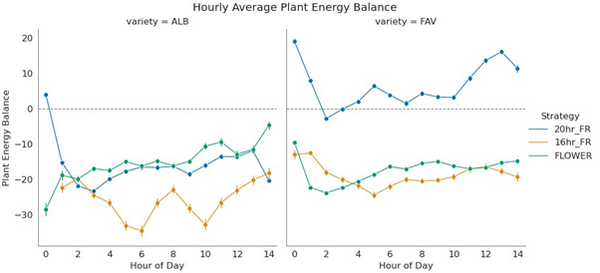"Plant sensors that can indicate how the plant responds to all climate variables are crucial for further optimization of not only the lighting strategy but the entire greenhouse climate," says Gert-Jan, a lead agronomist at Agrolux.
Strawberries have emerged as an exciting new crop in indoor agriculture, driven by year-round market demand. Efficient winter production in greenhouses is enabled with extensive supplemental lighting, but the high operational costs make optimizing lighting strategies crucial for profitability. Gardin, a phenotyping agtech, and Agrolux, a supplier of horticultural lighting, set out to demonstrate the use of chlorophyll fluorescence measurements of photosynthesis as a technique to optimize lighting strategies in strawberry production in an ongoing trial at Delphy Improvement Centre in the Netherlands.

Gardin's sensor has been able to quantify the difference in performance of three different light treatments on two strawberry varieties, Albion and Favori, regarding photosynthetic performance and how that relates to berry quality and yield. Notably, photosynthesis under sunlight for Albion was 12% more efficient than Favori (P<.005), resulting in a 28% increase in the proportion of harvested berries larger than 35mm (P<.005). By measuring the plant in this way, growers can identify differences in plant response weeks ahead of visible crop changes and use this information to select the most effective lighting strategies.
Linking climate and plant health
In this study, Favori and Albion strawberry varieties have been grown under three different lighting conditions: (1) 4hr low intensity extension, 16-hour high intensity, end of day far-red, (2) 16-hour high intensity with end of day far-red, (3) 16-hour high intensity with night interruption flowering bulbs. Each treatment was measured using Gardin's novel photosynthesis sensor to understand the plant response under each light treatment and establish the impact of each on plant stress factors.
At the heart of this novel approach to growing is chlorophyll fluorescence, a remarkable indicator of plant health and stress. This measurement, performed by Gardin, captures the emission of light by chlorophyll in every plant species, offering critical insights into how plants react to varying climate and lighting conditions. Using Gardin's proprietary analytics, growers can understand plant stresses in real time to steer the climate for optimum plant performance.
Gardin's Plant Health monitor instantly compares the efficiency of photosynthesis across each treatment; in this study, the Albion variety has outperformed Favori for each treatment by an average of 12% (P<.005), resulting in a 28% higher fraction of berries with size larger than 35mm (P<.005) - this included normalization for differences in planting density between the two varieties. The difference is largest for the flowering bulbs (24%), then 4hr extension (9%), and smallest for 16hr+FR (5%). On average, across both varieties, the far-red treatment had the highest photosynthetic efficiency, and the 4-hour extension treatment had the lowest.

From measurements to outcomes
Gardin's measurements have been able to establish significant differences in plant productivity for each lighting strategy, which has a direct correlation with the quality and size of the strawberries that are produced. Specifically, the harvested berries were separated into two groups by those greater or less than 35mm in size, and the fraction of harvested berry yield (grams) of each group was tracked each week.
16hr-FR lighting strategy had the highest photosynthetic performance, 27% higher than flowering bulbs and 12% higher than 4hr extension treatment. The fraction of berries >35mm for each treatment was 0.50: 0.40: 0.48, respectively, reflecting the same trend.
Over the part of the trial, the plants experienced a stress that led to reduced photosynthetic efficiency; as this occurred, the fraction of berries >35mm decreased while the fraction of smaller low-value berries increased. This means that by using Gardin to monitor plant photosynthesis, farmers can predict and influence the outcome of their crops to grow higher-quality berries.

Quantum yield of photosynthesis
Gardin's Plant Energy monitor determines whether the plants are light-limited or light-saturated. Under the same light intensity, plants that are more light-limited are able to convert more energy into sugars usefully rather than wasting excess light as heat. The 16hr+FR treatment is the most light-efficient and least light-saturated treatment for both varieties. The 20-hour treatment demonstrates the lowest efficiency and most light saturation, which peaks at the end of the day after 16+hrs of lighting. This is particularly stark for Favori, which is light-saturated for the entire day, suggesting the 4-hour extension at low light is not beneficial to Favori's development. This is reflected in 20hr Favori yielding the lowest fraction of berries >35mm in size.
"Gardin sensors added value in seeing a response before we saw the crop deteriorating. I could definitely see the sensors being used to enhance quality and yield in lit crops, particularly as a way to increase their light use efficiency." Says Stijn Jochems, Researcher at Delphy Improvement Centre.

Hourly average plant energy balance
Driving better practices with plant-driven growing
This collaborative investigation provides valuable insights into optimizing strawberry lighting strategies and demonstrates the use of chlorophyll fluorescence to quantify plant performance in commercial greenhouses. "The findings underscore the importance of a plant-centric approach in greenhouse cultivation. Using feedback from the plant, growers can make rapid adjustments to their climate and lighting strategy to significantly benefit photosynthesis," says Julian Godding, Lead Data Scientist at Gardin.
This approach not only optimizes growing conditions but also directly contributes to the production of larger, superior-quality strawberries. Gardin offers an affordable method for growers to understand and respond to their crops with greater precision.

For more information:
Gardin
Damiana Price, Head of Marketing
[email protected]
www.gardin.co.uk
